Content
Champignons look different, there are many varieties of them. To recognize an edible mushroom in the forest, you need to figure out what they are, and what are their external features.
What champignons mushrooms look like
Lamellar mushrooms can be very small or large in size - from 3 to 25 cm in diameter of the cap. The champignon cap itself is always massive, round and ovoid at a young age, but then straightens and flattens. Its surface is smooth or slightly scaly, the color of the fruit bodies of different species varies from white to brown and brown.
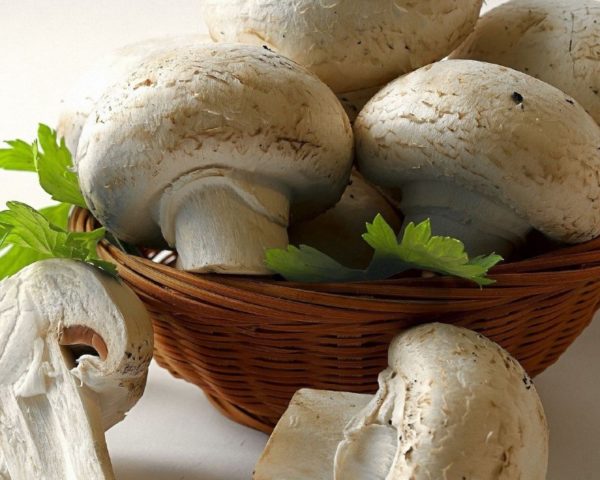
All types of champignons have common features.
On the lower surface of the cap there are plates, white at a young age, turning pink and darkening during the ripening process. The stem of the mushrooms is dense and even, sometimes loose and hollow, with a single or two-layer ring, the remains of the bedspread.
At the break, the fruit bodies are white and with a pronounced aniseed or mushroom aroma. When exposed to air, the pulp often takes on a reddish or yellowish tint.
Types of champignons
It is customary to distinguish several varieties of champignons. Although all mushrooms belong to the same genus, they can vary quite a bit in appearance and size.
Ordinary
The most common type is a mushroom with a dense stalk up to 9 cm in height and a convex or flattened white or grayish cap. The diameter of the cap reaches 15 cm, the skin on it is dry, it can be easily removed when cleaning.

Common species is most common
The flesh of the mushroom is dense and white, turning pink when broken. The common species is completely edible and suitable for any food use, and usually grows on fertile land in open areas.
Field
The fungus grows mainly in pastures and lawns, as well as in forest glades. The hat of the champignon in adulthood is open, up to 15 cm wide and silky to the touch. The mushroom is whitish or grayish in color, it rises 12 cm above the ground. There are pinkish plates on the underside of the cap.
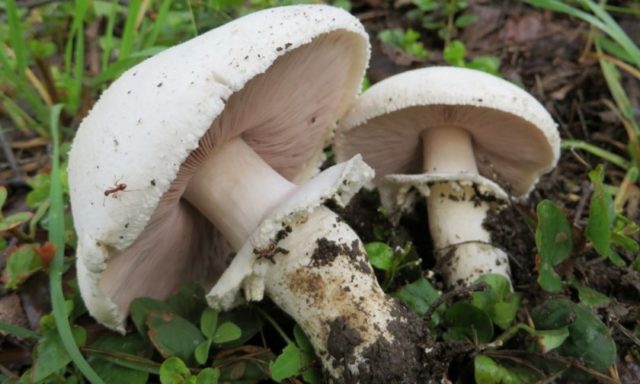
The field species grows mainly on lawns and pastures.
The field species has a white, yellowing on the cut flesh with a pleasant taste and smell. The mushroom grows from May until the first frost, you can use it in any form.
Forest
Unlike most mushrooms, forest mushrooms do not grow in open areas, but in the forest. Basically, the mushroom can be found in spruce forests, sometimes in mixed plantings. Its height is 5-10 cm, the width of the cap is on average 10 cm. The latter in the forest mushroom in adulthood is brownish-brown, with large dark scales.
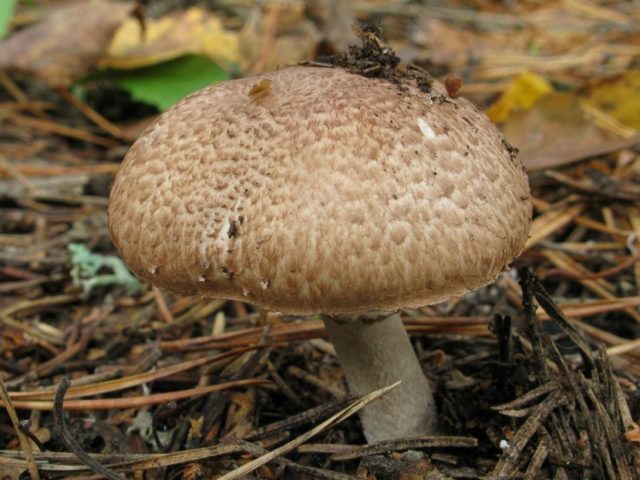
Forest mushroom is darker than many related species
A distinctive feature of the forest species is that its light pulp quickly turns red when cut. The mushroom is completely edible.
Augustow
This species is one of the largest in size of all champignons. In adult fruiting bodies, the diameter of the cap can reach 20 cm. The species grows in coniferous and mixed forests. It is not common, but it is easy to recognize it by its light yellow or dark orange open hat with brown scales.
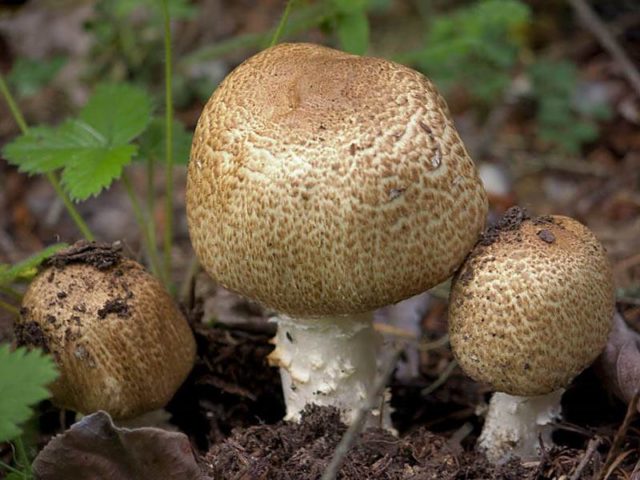
August view is one of the largest
The color of the flesh of the August mushroom is white, it smells slightly of almonds and is edible. Grows in forests from August to mid-autumn.
Bernard's champignon
The fungus belongs to the category of rare and grows mainly in Central Asia, on desert soils. The caps of fruiting bodies are prostrate in adulthood and convex at a young age, relatively small - up to 10 cm.The mushroom rises in height by 6-8 cm.
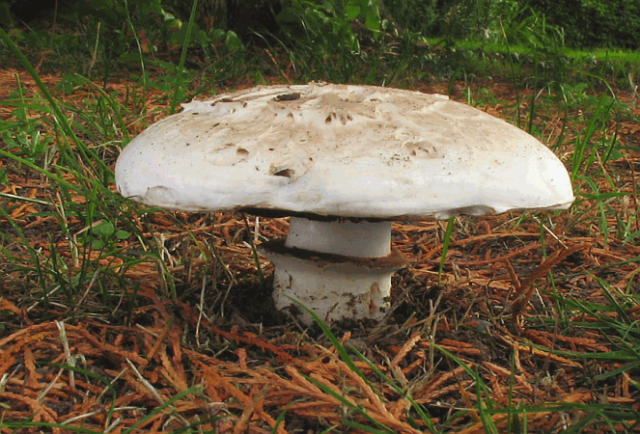
Bernard's champignon grows mainly in the steppes
The skin color of fruit bodies is usually white with a pinkish or brown tint. The flesh on the cut is white, but turns pink when exposed to air. Fruit bodies are suitable for human consumption.
Champignon Beneša
In nature, the species is rare, but you can find it in forests, both coniferous and deciduous. The mushroom has a fleshy open brownish cap with a blunt tubercle, up to 10 cm in diameter. The plates of fruit bodies are pinkish at first, turn brown with age, the stem is white and cylindrical.

Champignon Beneša turns red from contact with air
Edible champignon Beneša is white in the cut but turns red afterwards. You can eat the mushroom, including raw.
Garden
Mostly this species is grown industrially, but sometimes it is found in natural conditions - in gardens, in fields and on compost heaps. The diameter of the mushroom usually does not exceed 8 cm, on the stem it rises up to 10 cm. The cap at the fruiting body can be white or brown, smooth in the center and along the edges.
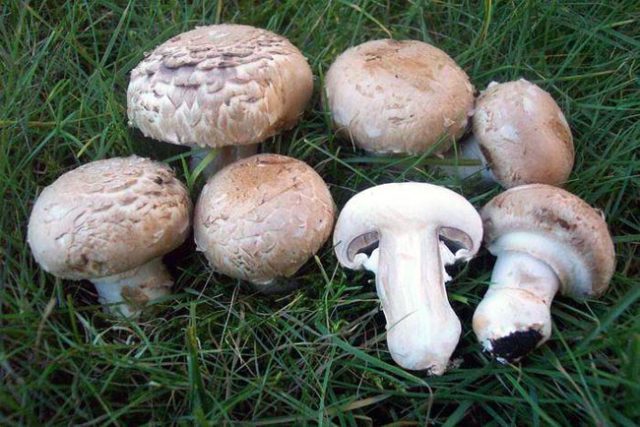
A garden view can accidentally grow in a summer cottage
The pulp of the mushroom is juicy, turns pink on the cut. The edible qualities are highly rated.
Elegant
Quite a rare species that grows in meadows and glades. The diameter of the cap does not exceed 3.5 cm, and the height is only 3 cm. The miniature fruiting bodies have a gray-yellow color with a pinkish tint, their caps are dry and dull. The plates in young mushroom fruits are pink, while in adults they are red-brown.
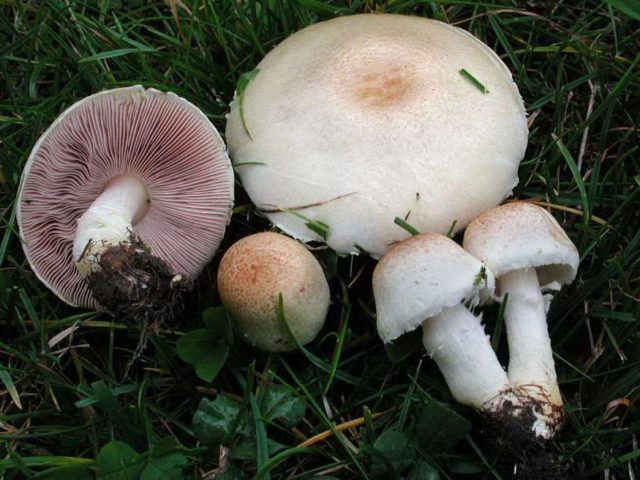
Slim design and miniature size
The mushroom can be recognized by its pungent aniseed smell; after processing, it is very tasty and is actively used for culinary purposes.
Large spore
A fairly common species grows mainly in meadows on fertile soils. In height it can reach 10 cm, the cap sometimes grows up to 25 cm in width. The surface of the cap is dry, covered with wide scales, the skin is whitish in color.
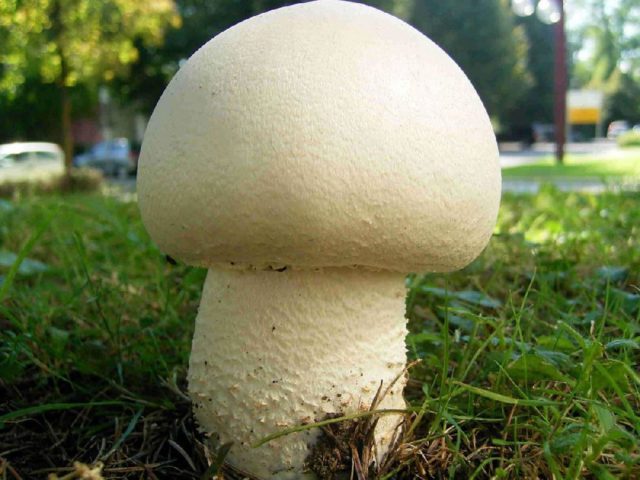
Large spore species - very large, light in color
If you break a large-spore champignon, then its flesh will turn out to be white, but it will quickly turn red in the air. An almond-ammonia characteristic smell emanates from the pulp.
Coppice
The species is relatively small - up to 10 cm wide, but it can also rise up to 10 cm in height. The cap of the coppice champignon is white or creamy, prostrate-convex and almost without scales. The dense, thin flesh has an aniseed odor; upon contact with air, it becomes yellow-orange.
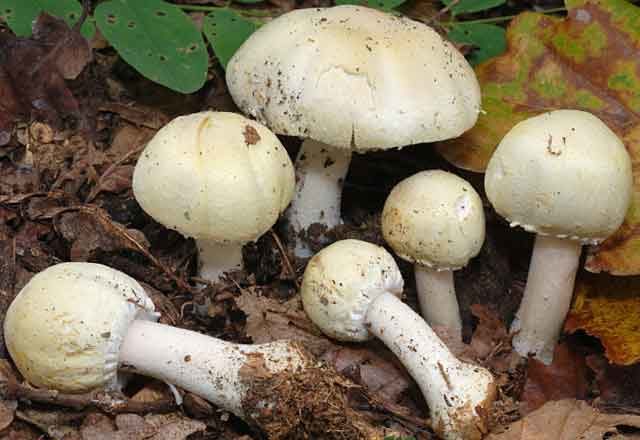
Photos of mushrooms allowing correct identification by class and species. Colored unique photo, taken in the forest. Coppice species has almost no scales on the cap
The stem of the mushroom fruit is thin and hollow, and usually retains a noticeable white ring. The edible species grows mainly in forests.
How mushrooms grow in the forest
Champignons of all kinds feel most comfortable at moderate temperatures. Most willingly, mushrooms start growing at 20-23 ° C. And if in the process the weather changes, and the temperature drops to about 14 ° C, the mushrooms turn out to be especially beautiful and strong.
Like most mushrooms, champignons prefer high humidity.You can find them in forests and fields soon after heavy rains, since humidity at the level of 75-95% creates ideal conditions for them to grow.
Since the mushroom mycelium is located shallow underground, natural moisture reaches it very quickly, and the mushroom fruits start growing. It should be borne in mind that the corresponding conditions for growth are created precisely by prolonged rains. A short downpour or light drizzling rain will not contribute to the germination of mushrooms, since they will not have time to saturate the soil with moisture.
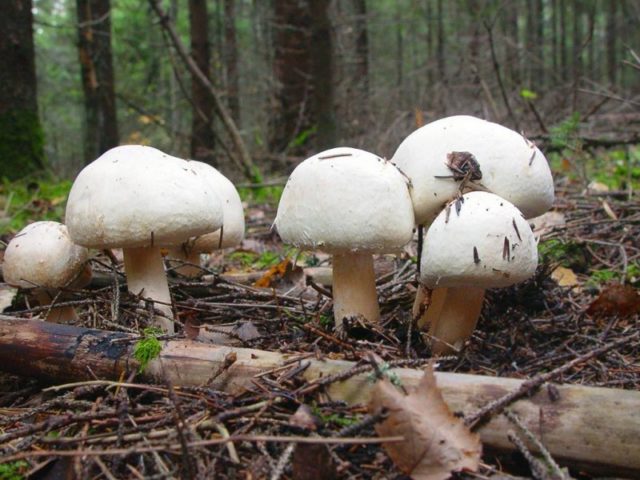
For the growth of mushroom bodies, a moderately warm temperature without sudden changes is important.
How many mushrooms grow
On average, the growth of fruiting bodies takes about 3-6 days, this is how long it takes for mushrooms to reach medium size. Fruit bodies reach their maximum size 12 days after emergence above the ground. Growth most likely occurs in the first days, up to 1.5 cm per day, after which the rate decreases slightly. An adult champignon can, on average, weigh about 200 g.
Interestingly, in warm and dry weather, mushrooms age much faster; it is better to collect them in the middle of their life cycle. But in the fall, with the onset of rains and cold weather, the fruit bodies retain their elasticity and freshness longer. Therefore, the largest specimens suitable for food consumption can be found precisely in the autumn period.
Where mushrooms grow in nature
Champignon is a mushroom very widespread all over the world. You can meet him throughout Europe, in England and in the Scandinavian countries, on the American continent. Mushrooms grow in the southern regions - in Central Asia, in the Crimea, in the steppe and even desert regions.
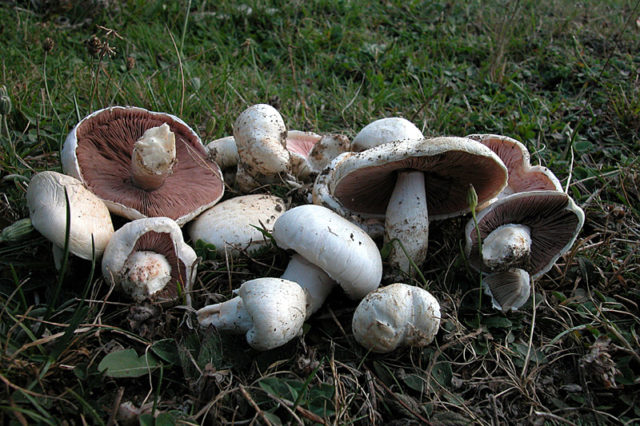
You can meet mushroom bodies all over Russia on rich soils
Edible mushrooms can be found almost everywhere on well-fertilized soil rich in organic compounds. Mushroom fruits grow in vegetable gardens and pastures, in swamps and along roads. Sometimes you can see them even in the city, although they are not suitable for harvesting in this case, in the city the pulp picks up too many toxins.
Where mushrooms grow in Russia
On the territory of Russia, mushrooms can be found almost everywhere, the mushroom is not at all rare. In particular, the following fruitful places, which are very popular with mushroom pickers, can be named:
- A forest near the village of Saburovo near Opalihi, and a forest near the Nakhabino station in the Moscow region. These places are of particular interest to mushroom pickers, since every season a huge amount of mushrooms can be collected here.
- Sverdlovsk region in the Urals. According to experienced mushroom pickers, many types of edible mushrooms grow in the local swampy forests, and they can be collected in whole baskets.
- In the middle lane, good harvests of champignons are observed in the Astrakhan and Volgograd regions. If you go mushrooming in the meadows and mixed forests in these areas, you can pick up a lot of edible fruit bodies during the season of maximum fruiting.
- Champignons also grow in Siberia. In particular, they can be collected in the Barnaul region and in the Krasnoyarsk Territory, and fertile places are found near Novosibirsk.

There are places with good harvests of mushrooms in almost all regions.
When mushrooms grow
The champignon season begins at the end of spring - the first mushrooms of the early species appear in May. However, in spring and early summer, fruiting bodies do not grow too abundantly. The mass fruiting season begins in July and August, after which you can pick mushrooms in large quantities until November.
When can you pick mushrooms
It is best to go for mushrooms in forests and meadows during the second wave of fruiting - from July to August. It is recommended to choose days about a week after heavy rains. During this time, the fruit bodies have time to ripen properly, but still do not become too old and darkened.
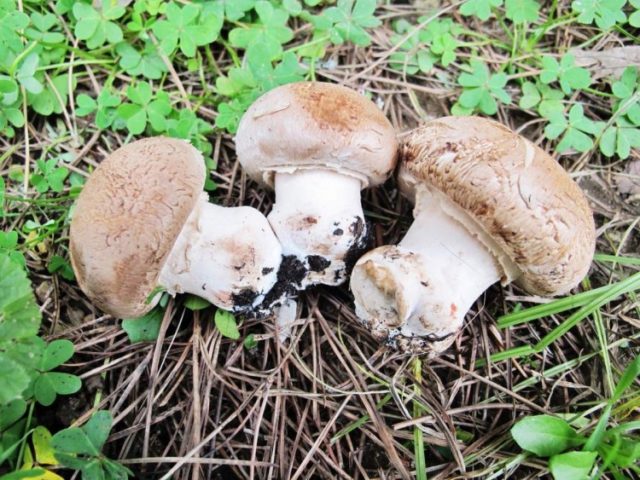
It is better to collect mushroom bodies during the second wave, at the end of summer.
They continue to harvest champignons until October. You can find edible mushrooms later, before the first frost and snow. But such a late find will be the exception rather than the rule; it is better to purposefully go in search in warm autumn weather.
How to pick champignons correctly
Champignons are very popular due to the fact that most of the species are absolutely edible. They can be safely consumed even raw. But that is why, when collecting fruit bodies, you need to choose the most environmentally friendly places. Like any mushrooms, champignons easily accumulate toxins from the soil and precipitation during the growth process. If contaminated mushrooms are collected, after minimal processing, they can lead to poisoning.
Collection rules:
- It is recommended to collect champignons directly with great care. Near the adult fruiting body, miniature rudiments of young mushrooms usually grow.
- If you pluck the champignon from the ground carelessly, you can damage the mycelium, and this will lead to the death of germinating mushrooms.
- To extract the fruit body from the ground according to the rules, you need to carefully take it by the leg and start turning it clockwise or counterclockwise. The champignon is thus unscrewed from the mycelium, and the mycelium itself remains intact.
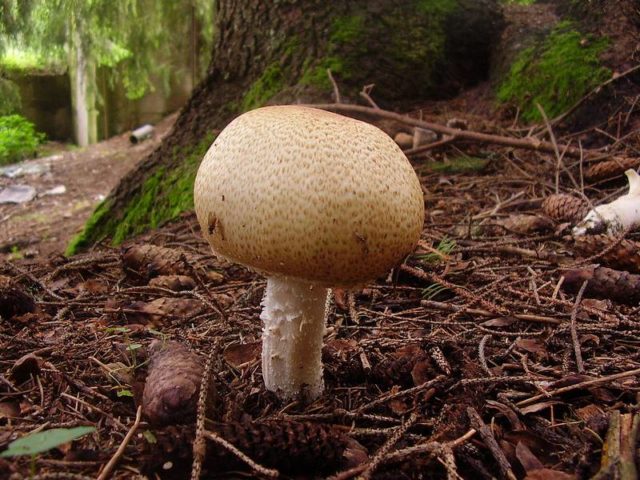
According to the rules, mushroom fruits must be twisted out of the ground with slow movements.
Often, mushroom pickers use a sharp knife to quickly cut off the fruit body from the stem without damaging the mycelium. However, in the case of champignon, this cannot be done, the remaining "hemp" will prevent the growth of small mushrooms.
Conclusion
Champignons do not always look the same, but there are common features in their structure. Recognizing these mushrooms is quite simple if you know the places for collection and the time of the main fruiting.








